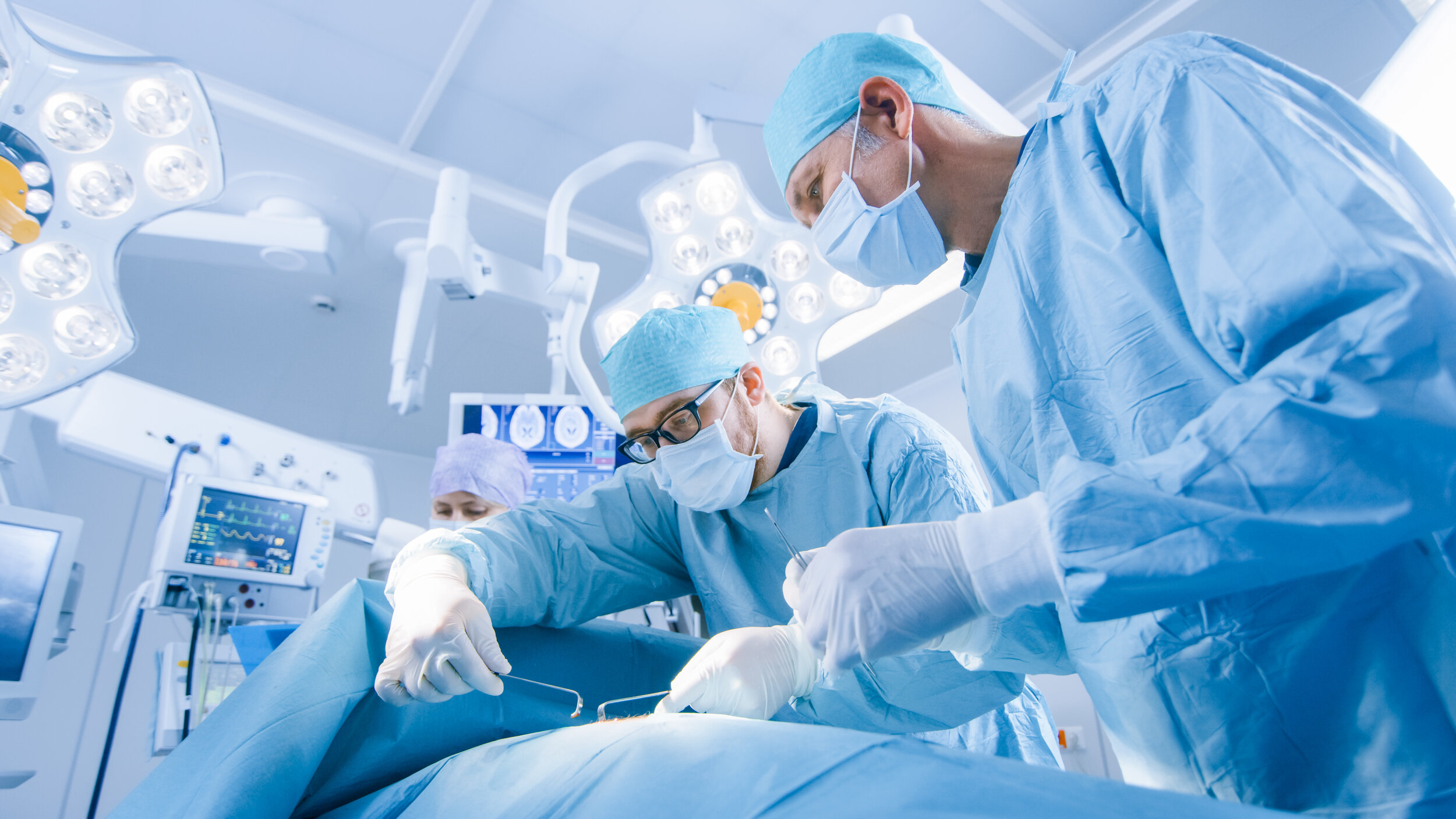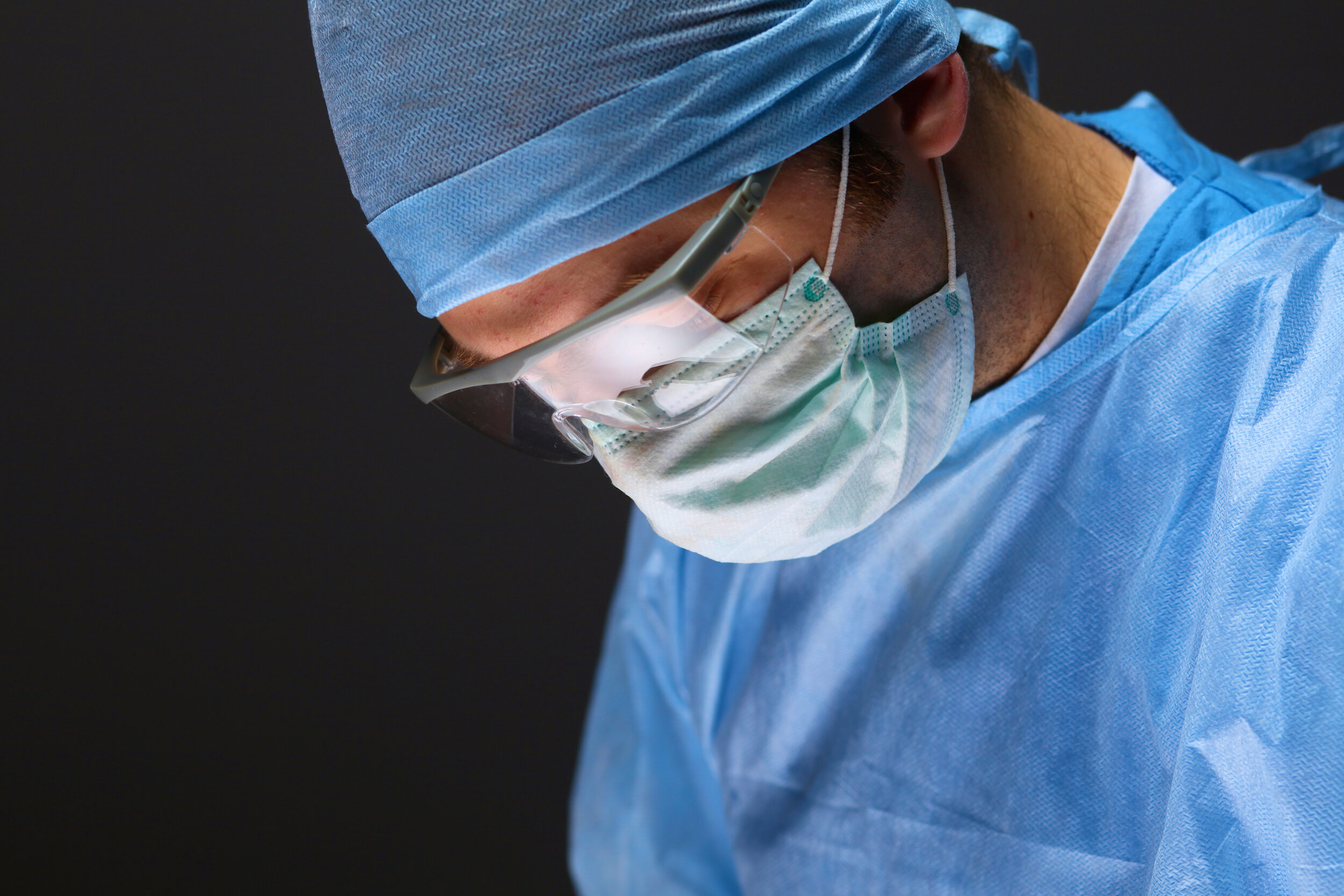Treatments: Thyroid
Thyroid problems are diverse, including problems with how much thyroid hormone is produced, cancers or nodules suspicious for cancer, autoimmune problems, and excessive growth. Treatment for each situation is accordingly diverse. Below are some of the main treatments used for thyroid problems.
Removal of the thyroid gland (total thyroidectomy)
Total thyroidectomy is a surgical procedure to remove all thyroid tissue that can be seen. Although this involves removing the entire gland from a gross structural standpoint, it is well known that some thyroid cells typically remain behind. Patients with normal parathyroid anatomy, meaning having four glands, all in close relationship to the thyroid, may experience low parathyroid gland output following thyroidectomy. If this occurs, it is usually temporary, with a reported rate of permanently low parathyroid hormone (hypoparathyroidism) being around 2%. Also with total thyroidectomy is the dissection of thyroid from the recurrent laryngeal nerves and the superior laryngeal nerves on each side. Temporary hoarseness after thyroid surgery is commonly related to the breathing tube placed between the vocal cords, but long-term hoarseness due to weakness of one or both vocal cords is thought to be about 2%. If that were to occur, there are procedures available to improve the voice, such as vocal cord injection medialization or medialization thyroplasty. When the entire thyroid gland has been removed, replacement of thyroid hormone is needed to prevent hypothyroidism, and this is in the form of one pill of levothyroxine (Synthroid) per day taken on an empty stomach.
Removal of part of the thyroid gland (Partial thyroidectomy)
A procedure in which less than all of the thyroid is removed is called a partial thyroidectomy. Usually, this takes the form of hemithyroidectomy and isthmusectomy. Removing just the nodule of concern would seem to make sense, but is not done for several reasons that come down to risk and benefit. By leaving the remaining thyroid lobe undissected, the parathyroid glands on that side and the laryngeal nerves on that side (recurrent laryngeal nerve and external branch of superior laryngeal nerve) are not at risk. Further, the remaining thyroid lobe may be able to produce all the thyroid hormone the body needs. If it cannot, supplemental thyroid hormone in pill form is used.
Radioactive iodine ablation
Radioactive iodine can be used to damages thyroid follicular cells and cancers derived from these cells (papillary and follicular thyroid carcinoma) in a technique called radioiodine ablation. Use of radioactive iodine cannot eliminate an entire thyroid gland, but it can shrink and slow activity of a thyroid gland (as sometimes is used for Graves disease), and it can often eliminate any microscopic collections of follicular thyroid cells after a total thyroidectomy.
Iodine with an atomic mass of 131 breaks down at a steady rate to a more stable element, 131-Xenon. In this process, it emits an electron. When given in pill or liquid form by mouth, 131-Iodine is absorbed by the gut, circulates in the blood, and then collects in the one tissue that takes up iodine—thyroid tissue. That is, wherever in the body that there is thyroid tissue, as long as it is still acting like thyroid tissue, it will take up and concentrate the circulating iodine. This allows the electrons generated by radioactive decay to be distributed very selectively to thyroid cells, whether in the thyroidectomy bed, or an area of thyroid cancer spread, such as a lymph node or the lungs. The electrons emitted by the decaying 131-iodine kill the surrounding cells, but since these electrons travel a very short distance (about 2 mm), the surrounding non-thyroid tissue receives virtually no radiation at all! This clever treatment technique works best when thyroid tissue is iodine avid, meaning it takes up iodine quickly and in high quantities. To make thyroid tissue iodine avid, a patient is either allowed to become temporarily hypothyroid (which increases TSH production, stimulating thyroid cell activity) or recombinant (synthetic) TSH is given intravenously shortly before the 131-iodine is given. This strategy works only when there is no more thyroid gland present (because even a remaining thyroid lobe would soak up so much of the 131-iodine as to leave an insufficient amount to treat any cancer metastases) AND when the thyroid cancer has not mutated so much that it no longer acts like it’s mother tissue and no longer takes up iodine.
Thyroid hormone replacement
When natural thyroid hormone production is inadequate, replacement of this hormone is necessary to avoid the consequences of hypothyroidism. Fortunately, the T4 thyroid hormone thyroxine is available for oral or I.V. use. Called levothyroxine (Synthroid ®), this medication is the identical molecule to T4 thyroid hormone produced by the thyroid gland. Treatment dosage is initially estimated on the basis of the patient’s age, weight, comorbidities, and degree of hypothyroidism, but then adjustments in the dose are made as needed over time based on blood testing.
TSH suppression using oral thyroid hormone
Keeping the concentration of thyroid stimulating hormone (TSH) low is a strategic method of lowering the chance of thyroid tissue from growing. In the context of thyroid cancer when the thyroid gland has been removed, the possibility of even tiny numbers of cancerous thyroid cells r. emaining in the body is reason to try not to encourage their growth.
TSH makes thyroid tissue more active. To a normal thyroid gland, contact with circulating TSH would cause increased activity and thyroid hormone production. When a thyroid gland is not producing enough thyroid hormone, increased TSH production is the body’s way to get the thyroid gland to produce more thyroid hormone. And when there is an excess of thyroid hormone in circulation, the pituitary gland produces less thyroid hormone, signaling a decrease in thyroid hormone production by the thyroid gland. In the case of thyroid cancer, TSH is also a stimulus for growth of the thyroid cancer cells, not just to make more thyroid hormone, but to become a more active cancer. For this reason, after surgical and possibly radioactive iodine treatment for thyroid cancer, keeping the TSH level reasonably low may be desirable. The way to keep TSH low is to give just enough thyroid hormone medication (usually with a daily pill of levothyroxine) to meet and slightly exceed the body’s need. This replicates a situation of an over-active thyroid gland as described above, and any potential thyroid tissue (cancer or non-cancer) remaining in the body will have expodure to less TSH to stimulate growth. Recent guidelines do not recommend thyroid-stimulating hormone (TSH) suppressive therapy with levothyroxine for benign nodules because the nodule shrinking effect is uncertain but may result in hyperthyroidism side effects such as long-term osteoporosis (weak bones) or atrial fibrillation (an irregular heart rhythm). For cancers, the benefits of TSH suppression may be worth these risk.
antithyroid drugs
Methimazole (Tapazole) and propylthiouracil (PTU) are used to medically limit the production of thyroid hormone in conditions of hyperthyroidism, including Graves disease, toxic multinodular goiter, and thyrotoxic crisis (thyroid storm). These anti-thyroid drugs are taken by mouth and take weeks to months for full effect. Since these medicines can cause liver problems or a problem in which the bone marrow fails to produce new blood cells (agranulocytosis), blood testing and monitoring for adverse effects is needed.
Lymph nodes and lymphatic channels are shown in green.
Removal of lymph nodes (cervical lymphadenectomy or “neck dissection”)
Thyroid cancers have the ability to spread to lymph nodes of the neck. Papillary thyroid carcinoma is especially prone to spreading to lymph nodes, whereas follicular thyroid carcinoma is less prone to spread to lymph nodes and relatively more likely to spread by blood to a tissue such as the lung. When thyroid cancer is suspected, ultrasound evaluation of the side of the neck can be undertaken to identify any suspicious neck lymph nodes. If found, typically ultrasound guided fine needle aspiration biopsy of one or more suspicious lymph nodes is undertaken. The pathologist’s reading of the needle biopsy is used in the decision-making for extent of surgery. If one or more lymph nodes on the side of the neck appears to have cancer spread to it, the surgical approach normally involves removing the entire thyroid gland (total thyroidectomy), the lymph nodes in the central neck (around the thyroid), and also the lymph nodes in the region of the known cancerous (“positive”) lymph node. This procedure, when done is skilled and experienced hands, can remove cancerous lymph nodes with maximal preservation of the important nerves, muscles, and blood vessels in the neck.
Percutaneous ethanol injection (PEI)
Percutaneous ethanol injection is the direct injection of ethanol through a needle or a catheter for the purpose of atrophy of a benign and predominantly cystic (having >50% fluid content) thyroid nodule causing symptoms such as a neck bulge or pressure. It is not typically used for cancerous nodules, and follow-up on a nodule treated with PEI is necessary to watch for signs it may be malignant. Recently, PEI has been advocated for use in highly selected thyroid cancers in special circumstances in which surgery is not an option (if the patient is not healthy enough for general anesthesia, for example). Larger nodules require repeated treatments.









